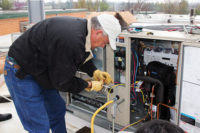Distributors Benefit from Regional Standards Sales
Savvy wholesalers are reaping the rewards of stocking up on 13-SEER equipment

STOCKING UP: Ferguson Enterprises decided to stock up on 13-SEER equipment ahead of the DOE standard, but noted that determining how much to purchase was a difficult decision.

BUYING CHALLENGE: Not only was it difficult to decide how much 13-SEER inventory to buy, it was a challenge for Ferguson Enterprises to figure out where to store all the inventory.


The U.S. Department of Energy’s (DOE’s) new minimum-efficiency standards for residential air conditioners and heat pumps went into effect Jan. 1, 2015, marking the first time efficiency requirements differ based on the state in which the equipment is installed.
The new standards divide the country into three regions — North, South, and Southwest — each of which boasts unique minimum efficiency requirements that consist of varying combinations of SEER, EER, and HSPF (the exception being split system heat pumps, which now have a nationwide minimum efficiency requirement of 14 SEER/8.2 HSPF).
For distributors, it was déjà vu all over again, as they had to decide — as they did back in 2006, when minimum efficiency standards rose from 10 SEER to 13 SEER — whether to stock up on minimum-efficiency equipment ahead of the deadline. Most decided to do so then. Their decision was made easier this time as the standards’ 18-month sell-through period allows distributors to sell noncompliant equipment as long as it was manufactured before Jan. 1, 2015.
“Everyone in the industry is on the side of energy conservation, but the complexity that the regional standards impose on many wholesalers, especially those that are in border states, creates a real burden for those operations, as they now face supply chain issues,” said Tom Perić, editor, Distribution Center magazine, the official publication of Heating, Air-conditioning, and Refrigeration Distributors International (HARDI). “The longer sell-through period was a boost for wholesaler planning, but we still need a better communications channel with the DOE whenever we must deal with regional standards.”
LONGER SHELF LIFE
This longer sell-through period is the reason why Daniel Hernandez, market sales manager, Phoenix Wholesale, decided to stock a large amount of 13-SEER equipment ahead of the cutoff date. “We knew we’d have more than a year to sell it, and, in hindsight, it was a smart decision. Many people are still recovering financially from the economic downturn, and the 13-SEER equipment is helping us reach the price-driven market while providing a value product. We’re still selling 13-SEER equipment, but, after this current summer peak season, it’ll be almost completely gone.”
Matt Lattanzi, director of warranty and technical services, Nortek Global HVAC, noted that many customers — particularly those in the South — stocked up on 13-SEER equipment ahead of the standard. “We also saw some buy-ahead for 13-SEER heat pumps nationwide.”
Carrier also saw an increase in orders of 13-SEER units at the end of 2014, said John Gibbons, director of residential product management and strategy, but it was very modest. “Most of that increase was inventory needed to finish out large projects and some new construction where a builder wanted comparable equipment within a given subdivision. We believe, similar to other regulatory changes, that most contractors embraced the change and moved to 14-SEER-minimum equipment sooner rather than later, and many used the efficiency change to differentiate their selling approach.”
Ferguson Enterprises decided to stock up on 13-SEER equipment ahead of the standard, but determining how much to purchase was difficult, said Alex Hutcherson, vice president of HVAC. “In making our decision, we used historical demands, consulted our vendors concerning 13-SEER production schedules, and requested feedback from customers. In the end, we purchased enough units to last approximately six months. We’re out of some models today, and, by the end of the summer, we’ll have minimum inventory levels in most southern locations.”
Not only was it difficult to decide how much 13-SEER inventory to buy, it was a challenge to figure out where to put it all, said Hutcherson. “With the additional 14-SEER equipment needing to be prepared for contractors while completing sales of 13-SEER equipment, we’ve experienced a squeeze on warehouse space.”
There is still 13-SEER equipment available at Century A/C Supply, said Jess Mattox, vice president of sales, who noted the company purchased a fair amount of inventory prior to the cutoff date. “We bought equipment based on several factors, including our sales history, budget, and warehouse availability. We still have inventory, and it should last us to the extent of our plan.”
Richard Cook, president and COO, Johnson Supply, also stocked up on 13-SEER equipment, but he noted that weather has dampened sales so far this year. “We’ve sold a fair amount of the 13-SEER inventory, but we’ve also had a very cool, rainy spring. I’m not sure how much effect that has had on sales, but we expect to be out of purchased inventory by this fall.”
Sales may also increase as more contractors become aware of the new standard and rush to buy 13-SEER equipment before it is gone. “It took three or four months to educate our customer base about the new standards, and, because of the late heat in our market, there are still some who are not aware of the changes,” said Cook.
LONG-TERM EFFECTS
While many applaud the efforts to reduce energy consumption, there is concern the new standards will cause more problems than they solve. “The new standards have complicated the industry, and it’s always the unintended consequences that have the largest impact,” said Lattanzi. “Time will tell if there is a negative impact, but the immediate changes are apparent: Selling HVAC is now more complex for distributors and contractors; the equipment is more expensive; and, for distributors serving multiple regions, inventory costs are likely to rise.”
Mattox understands why the DOE created regional standards based on different climate areas, but he agrees they could cause issues for distributors and contractors who serve more than one region. “Being entirely in Texas, we’re not near a regional border, and we only serve the Southwest region. Once our current inventory of 13-SEER equipment is depleted, we’ll not be faced with some of the controls that other ‘borderline’ distributors may face a continued demand for 13-SEER products. A national standard would simplify business for those border entities as well as for manufacturers.”
The new standards may also encourage buying lower-efficiency equipment online, especially by price-sensitive consumers. “Contractors know that factory warranties are voided if they buy online, but homeowners do not,” said Hernandez. “We’re seeing more and more homeowner-direct HVAC sales popping up, and we’ve already started to hear stories about products purchased online that are incomplete, mismatched, or just not working.”
The cost of 14-SEER equipment is also a concern to Cook, who believes the higher price will continue to make HVAC less affordable for the average homeowner. “At the wholesale level, there is not a significant difference in price between 13- and 14-SEER equipment, and I don’t know how that difference translates for most consumers. We’ve been seeing the trend to repair rather than replace over the last few years as the cost of HVAC equipment to homeowners keeps rising.”
Ferguson estimates the cost difference to manufacture a 14-SEER product is 8-12 percent higher than a 13-SEER product, which translates into a 10-20 percent increase for the consumer. “However, consumers getting a more efficient product and will realize a cost savings on their energy consumption,” said Hutcherson. “In some cases, this upfront price increase may initially lead consumers to repair instead of replace, but when they look at the long-term return on their investment, a replacement is probably more cost-effective.”
There is some good news regarding cost, said Hernandez, who noted homeowners are buying both 13- and 14-SEER R-410A equipment. “What’s really forcing homeowners to replace rather than repair is the high price of R-22. That’s doing more for replacement sales than the new efficiency standards.”
Assuming the standards are properly enforced, Gibbons believes they’ll ultimately benefit the industry, because contractors in southern regions will be able to demonstrate a better payback and energy savings opportunity to consumers when proposing the 14-SEER products. “Similarly, these same contractors can show even more savings by proposing products higher than 14 SEER in the regions that make the most sense. In addition, northern contractors can continue to sell 13-SEER units because operating hours are lower.”
While it remains to be seen how the new minimum-efficiency standards will impact the industry as a whole, most distributors are breathing a sigh of relief that their decision to stock more 13-SEER equipment is paying off, leaving them time to start thinking about what to do with the next round of minimum-efficiency standards, which the DOE is considering right now for residential furnaces.
Publication date: 9/7/2015
Want more HVAC industry news and information? Join The NEWS on Facebook, Twitter, and LinkedIn today!









